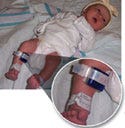Hospital Investment in RFID Seeing Rapid Increase
NEWS TRENDS
September 1, 2008
|
Radio-frequency identification is commonly used for infant protection programs. |
Faced with rising healthcare costs, labor shortages, and a stronger focus on patient safety, some hospitals are turning to radio-frequency identification (RFID). In fact, large hospitals are investing in RFID at an explosive growth rate, according to a recent market research firm study.
The study looks at the opportunities and challenges in setting up RFID systems for mobile asset and patient tracking, patient identification, and inventory management. It examines a form of tracking called real-time location services and passive RFID-based products, including materials management. It was conducted by Spyglass Consulting Group (Menlo Park, CA).
“The real underlying benefit is in enhancing patient safety, increasing operational efficiency, and improving business flow processes,” says Gregg Malkary, managing director of Spyglass Consulting. “[RFID is] a way [hospitals] can contribute the bottom line, where there's a compelling return on investment. This is primarily happening on a departmental level, where directors of clinical engineering are making investments in these solutions.”
The study, Healthcare Without Bounds: Trends in RFID 2008, made several conclusions:
RFID healthcare investments are experiencing growth in organizations with more than 300 beds, where it can be harder to track objects because of the larger physical footprint.
RFID investments are focused on departmental applications to solve specific business issues. On the other hand, hospital administrators are more hesitant to adopt RFID solutions on an enterprise-wide scale until its clinical, financial, and operational efficiency is proven.
RFID tracking solutions provide a compelling value proposition to increase operational efficiency, and streamline work flow and patient flow exchanges.
Passive RFID solutions are emerging for niche applications within hospitals for patient identification, inventory management, and quality assurance.
The strong growth in RFID investments can be attributed to the hospitals' desire to solve problems tracking their assets, patients, and staff, which can be accomplished using real-time location services. Equipped with a built-in battery, the RFID product uses tags that can be read up to 100 ft away. This form of tracking was among one of the strongest RFID trends revealed in the study.
Some hospitals use common RFID systems to locate equipment or for patient tracking such as infant protection systems. Using RFID to track staff is also gaining traction, but is viewed as controversial because the idea “reeks of Big Brother watching,” says Malkary. However, due to chronic labor shortages and the increase in healthcare costs, organizations want to fine-tune the work flow of nurses so individuals can accomplish more tasks. Real-time location tracking can be valuable for conducting time-motion studies of how and where nurses spend their time.
Passive RFID solutions, which are akin to bar codes or labels, are also emerging in niche areas where there's an interest in managing inventory for high-risk and expensive devices and drugs.
Adoption barriers for hospitals include return on investment and the site's current network infrastructure and maturity. One of the big challenges for smaller organizations is the RFID price points. OEMs worry about how long it will take for costs to go down.
There also needs to be better integration of RFID with healthcare information systems. “For example, with medical devices, how do we associate a patient with the device? Today, it's much more of a manual documentation process,” says Malkary. “If a medical device can autoidentify itself, we can automatically record the lot number, expiration date, etc., [and] we'd have greater association.”
According to Malkary, part of the integration relies on adoption of universal standards through large healthcare purchasing groups and GS1, a group that focuses on implementing global supply-chain standards.
Copyright ©2008 Medical Device & Diagnostic Industry
About the Author(s)
You May Also Like


.png?width=300&auto=webp&quality=80&disable=upscale)
